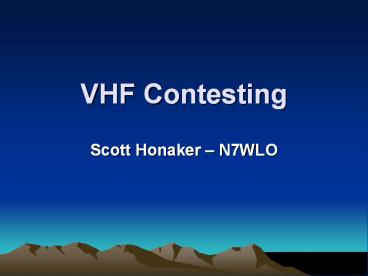VHF Contesting - PowerPoint PPT Presentation
Title:
VHF Contesting
Description:
More about location than station even playing ... Camper. Truck. Tent. Trailer. RV. Rodger KK7LK on Mt Anderson. Scott Honaker - N7WLO. 11. Rover Vehicles ... – PowerPoint PPT presentation
Number of Views:123
Avg rating:3.0/5.0
Title: VHF Contesting
1
VHF Contesting
- Scott Honaker N7WLO
2
Why Contesting?
- Emergency preparedness
- Familiarity with equipment
- Operating practice
- Competitive need
- Challenge
3
Why VHF?
- More about location than station even playing
field - Cooperative contest
- More relaxed
- Less band fighting
- No awkward antennas
- Everyone can play available to all class
licenses
4
Rules - Classes
- Single operator (high/low power)
- (Limited) multi-operator
- Rover
- Single operator portable (QRP)
5
Rules Grid Points
- Maidenhead Grids
- 1 degree latitude x 2 degrees longitude
- Either 4 or 6 character designator
- Covers the whole world
- Seattle is CN87, Bellingham CN88
- Vancouver, BC is CN89, Portland is CN85
- 1 Grid point for each grid contacted per band
- 1 Grid point for each grid activated
6
Maindenhead Grids
7
Rules QSO Points
- Modes (CW, SSB, FM)
- Most activity is USB on/near call channel
- A QSO is same points regardless of mode
- No additional points for additional modes
- Bands
- 6m to light
- Higher bands worth more points
- Exchange Call and grid square
- Score Grid pts x QSO pts
8
Equipment - Radios
- Multimode (CW, SSB, FM) most activity is SSB
- Multiband - 6m, 2m, 220, 440, 1.2 gig
- FM OK 2m and up
- IC-706MKIIG, FT-88100(D), FT-817, TS-2000(X)
- Dont forget IC-T81s, TH-F6A, etc.
- Transverters
9
Equipment Antennas
- Loops
- Beams Planars - Dishes
- Horizontal polarity
- Verticals only useful on 2m, 222, 446
- Arrow, Cushcraft, M2, KB6KQ, Par
- Mast/rope, telescoping masts, park-on mounts, etc.
10
Facilities
- Car
- Camper
- Truck
- Tent
- Trailer
- RV
Rodger KK7LK on Mt Anderson
11
Rover Vehicles
12
Mapping
- Delorme Gazetteer Identifies grid squares and
good operating locations - Topo data is critical for finding good operating
locations or route planning - GPS Can provide antenna bearings
- Locations scouted on
- http//pw1.netcom.com/n7cfo/locations.htm
- Radio Mobile software
- http//www.cplus.org/rmw/english1.html
13
Locations
- Altitude
- Access to population centers
- Unique grid squares
- Accessibility rover
- Beware of populated hill tops may need
intermod filters
14
VHF Propagation Modes
- Sporadic-E
- Most common on 6m
- Troposcatter/ducting
- Most effective on 6m through 70cm
- More common in summer, near water
- Aurora
- Works late at night on 6m and 2m
- Point antenna north
15
New Modes
- Not too common - yet
- PSK 31
- Similar noise immunity to CW
- Easily run on most laptops
- http//aintel.bi.ehu.es/psk31.html
- JT 44 with WSJT
- Copy up to 30dB below the noise floor
- Computer clock and radio freq must be accurate
- Not real-time, must be scheduled/arranged
- http//pulsar.princeton.edu/joe/K1JT/
16
PSK 31 Frequencies
HF Band Frequency VHF Band Frequency
160 M 1807 KHz 6 M 50.290 MHz
80 M 3580 KHz 2 M 144.144 MHz
40 M 7070 KHz 1.25 222.070 MHz
30 M 10140 KHz 70 cm 432.200 MHz
20 M 14070 KHz 33 cm 909.000 MHz
17M 18100 KHz
15M 21080 KHz
12M 28120 KHz Most PSK 31 is USB Most PSK 31 is USB
17
VHF During Field Day
- VHF/UHF QSO counts are notoriously low
- The vast majority of QSOs are voice
- FD scoring gives 1 point for voice, 2 points for
CW and 2 points for data QSOs - Typical VHF QSOs might be 80 all voice
- If 50 added soundcard modes, we get 5 points per
station rather than 1 point - 80 points becomes 240 points
- This doesnt count QSOs now possible with PSK/JT44
18
Strategies
- Make noise
- Pay attention to 6m band openings
- Track rovers and the bands they have
- Identify big stations with multiple bands
- Use CW/PSK/JT44 for extra QSO points
- Bring as many bands as possible
- Scan 2m FM simplex channels and 446.000
- Check out http//www.pnwvhfs.org
19
Monitoring Activity
- 50.125 50.200 MHz USB
- 52.525 MHz FM
- 144.200 144.250 MHz USB
- 146.580 FM and 2m simplex (not 146.520)
- 225.500 FM or 222.100 USB
- 432.100 432.120 MHz USB
- 446.000 MHz FM
- 1294.500 FM or 1296.100 USB
20
Additional Field Day Info
- Use HamScope/MixW/WSJT to make CW/PSK available
to all operators it all loads on the logging
machine - Arm the GOTA station with VHF and multimode
software - Anyone not operating should be contacting the VHF
and GOTA stations - Use down-time for JT44 contacts while
continuing to monitor other frequencies
21
Have Fun!































